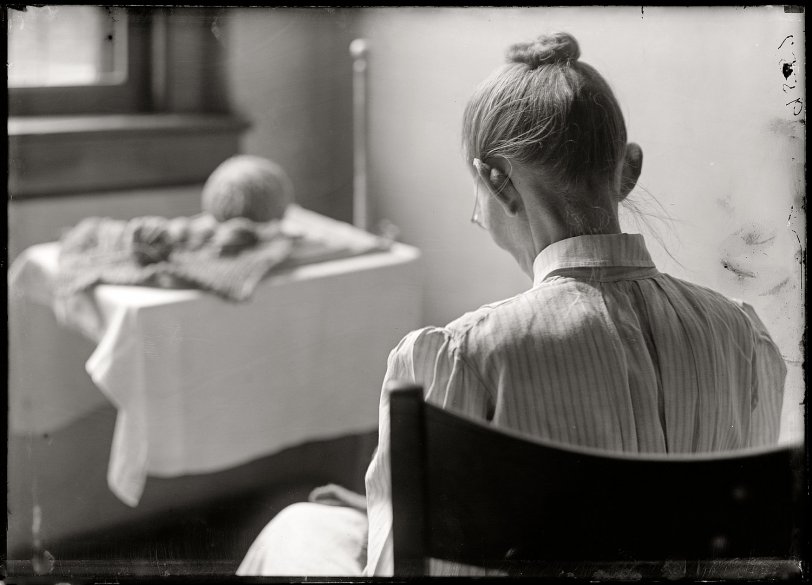


Framed or unframed, desk size to sofa size, printed by us in Arizona and Alabama since 2007. Explore now.
Shorpy is funded by you. Patreon contributors get an ad-free experience.
Learn more.

- Lost in Toyland
- And without gloves
- If I were a blindfolded time traveler
- Smoke Consumer Also Cooks
- Oh that stove!
- Possibly still there?
- What?!?
- $100 Reward
- Freeze Frame
- Texas Flyer wanted
- Just a Year Too Soon
- WWII -- Replacing men with women at the railroad crossing.
- Yes, Icing
- You kids drive me nuts!
- NOT An Easy Job
- I wonder
- Just add window boxes
- Icing Platform?
- Indiana Harbor Belt abides
- Freezing haze
- Corrections (for those who care)
- C&NW at Nelson
- Fallen Flags
- A dangerous job made worse
- Water Stop
- Passenger trains have right of way over freights?
- Coal
- Never ceases to amaze me.
- Still chuggin' (in model form)
- Great shot
Print Emporium
Insane: 1917

Washington, D.C., 1917. "St. Elizabeths, government hospital for the insane." Harris & Ewing Collection glass negative, Library of Congress. View full size.
Something not mentioned
My mother worked on genealogy for many years, for our family, and helped many others find their own family histories. She told me of many heartbreaking stories of middle aged women who were put away in mental institutions when they reached menopause, because the families, and sometimes just the husbands, thought their wives were mentally disturbed instead of suffering from a medical condition they did not understand or know how to properly treat. Severe cases of postpartum depression were frequently treated the same way.
I cannot imagine the horror, and am eternally grateful for the advances in medical care that mean I never have to find out.
Suitcases
http://www.suitcaseexhibit.org/flashSite.html
The Willard Suitcases
Stories and photos of people and possessions like the lady in the photo.
Poetry
Ezra Pound, a nutjob for sure, spent 12 years at St. Elizabeths and managed to get out with his sanity, if you want to call it that. But he did some great writing while he was there. Guess he had nothing else to do.
Details
She's clean. Her clothes are well made, clean, pressed. Someone let her--or helped her--put her clean hair up neatly. If she's using knitting needles, she's peaceful. And busy. There's a window and light. That's a lot to be thankful for.
A bit of history about St. Elizabeths
The book "The Professor and the Madman" tells the story of William Chester Minor, an editor of the first edition of the Oxford English Dictionary who was diagnosed as criminally insane. He died there in 1920 so it is entirely possible that he and this lady would have known each other.
Onto the street
I lived in Los Angeles during the Reagan years when mental hospitals were defunded, and large numbers of the mentally ill were turned out onto the streets. They became a disposal problem, just horrific.
Insane = politically incorrect
We prefer the expression "Mentally Hilarious," thank you.
Re: Asylum
I hate to break it to you, but the asylums of yesteryear were not exactly palatial. Yes, they were probably better than a tent, but the mentally ill often endured "treatment" that we cannot even fathom, simply because they lacked effective ways of treating patients and the understanding of mental illness was nascent. Prevailing attitudes toward the mentally ill were not always particularly kind then, either. I agree that we are a callous society today and that there is every chance that this woman would be living in a tent, but I think that she probably had a hard life with her condition in 1917 as well.
Asylum
In today's society, she would be homeless living in a tent.
Stopped me cold
A life in limbo, waiting.
Vita Brevis
An image so fine it reads like poetry -- the photographer's portrayal of emotion -- her countenance defines catatonia yet clearly she is working at a task -- no, no, there is no hope, except does the light passage imply the Lord is coming for her. Excellent job, photographer, you are indeed an artist.
Lonely indeed
Prove that a picture is worth 1000 words. Very simple, but speaks volumes.
Institutionalized
I was actually thinking that this picture makes it look like a soothing place. In the days before more effective drugs and therapy, that's the best one could hope for.
Portrait
This is actually quite a beautiful composition -- the blurred knitting, the vulnerable back of an anonymous woman's neck, her hair screwed into a severe topknot. At least she perhaps has needlework in her lap.
I think "lonely" is indeed the right word.
Quiet Dignity
Lonely, yes. And sad of course. But the photographer has allowed that poor woman her dignity -- something, I can't help thinking, that few modern photographers would do. In its small way -- the close-up of the back of the neck, and the wispy stray hairs, and the almost symbolic out-of-focus objects (knitting?) across the room, this strikes me as something of a masterpiece.
























On Shorpy:
Today’s Top 5